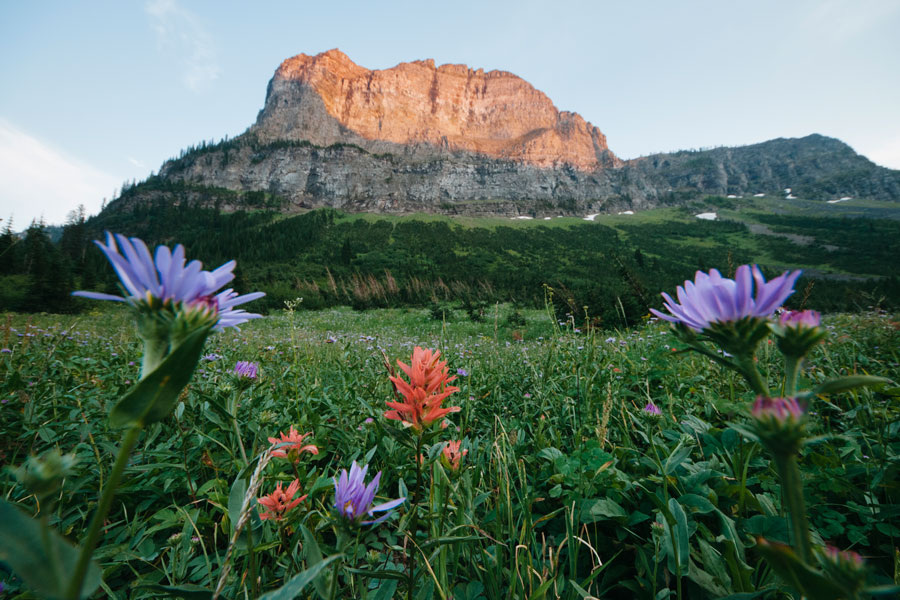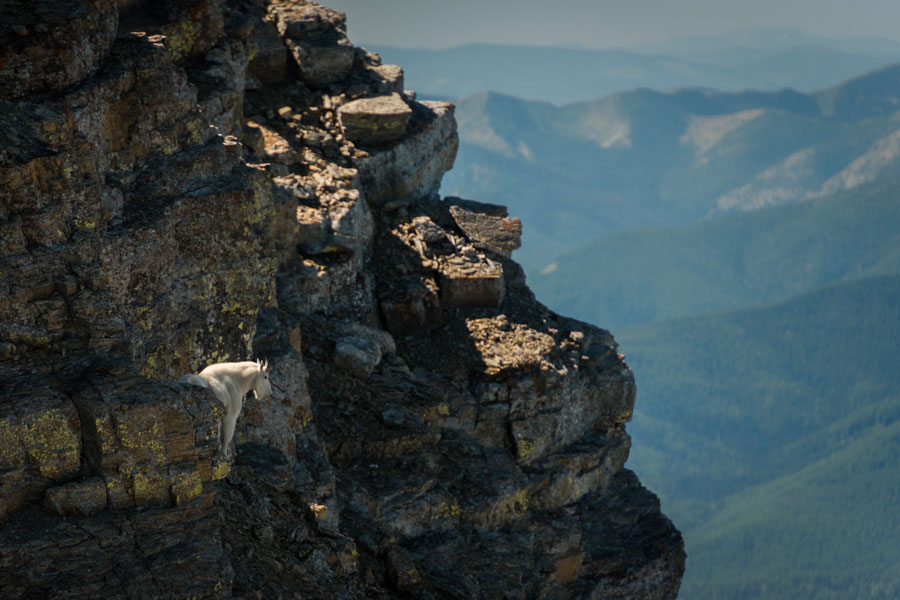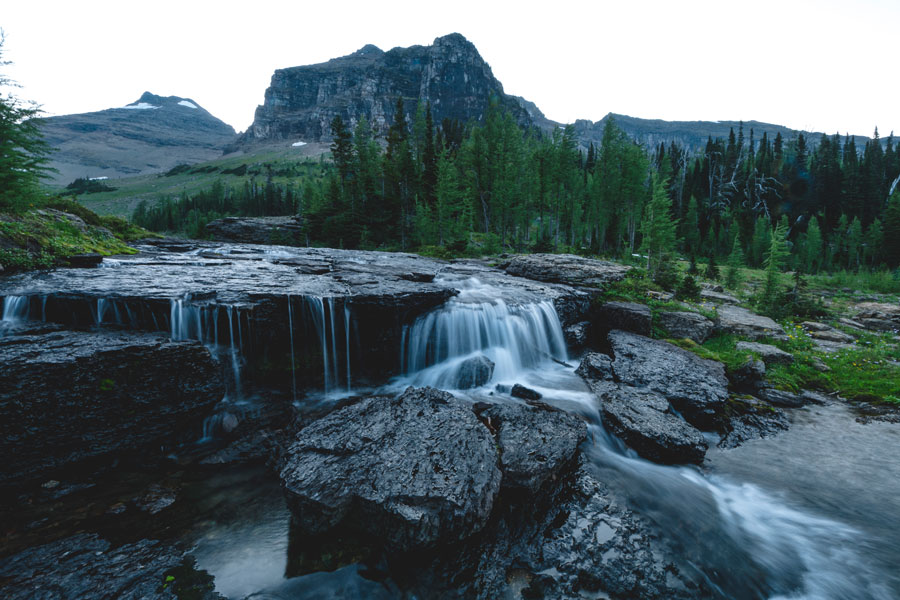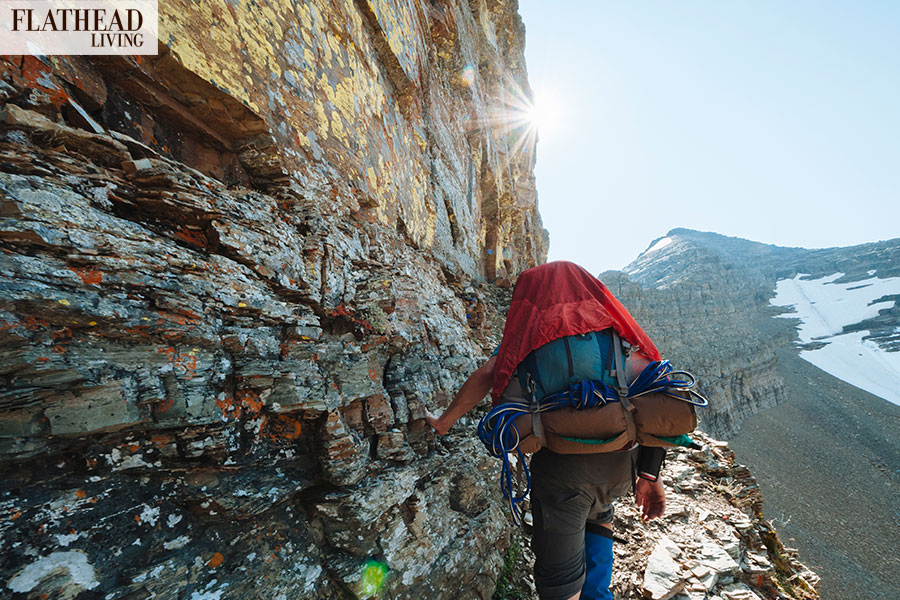On the ridge before us, a beast the color of winter hobbled on a broken left back leg. The mountain goat’s injury made him easy prey for predators and hunters. During hunting season, these goats wander in and out of protected areas, in and out of the range of hunters who value their snow-white trophy coats. The goat is protected from rifles by going into Waterton-Glacier International Peace Park in Alberta or Montana, but here in British Columbia’s Akamina-Kishinena Provincial Park, he can be legally hunted. Yet there’s no map to show him the route to protection, no lines on the land marking a safe passage. If he’s to find sanctuary, he’ll have to do it the hard way, through trial and error, with more than a fair bit of luck along the trail.
It was mid-August. The team of scientists and conservationists had been in Akamina-Kishinena Provincial Park for four days when we climbed the spine ridge to Forum Peak. We were there to glass for wildlife and to discuss Harvey Locke’s dream of expanding Waterton-Glacier International Peace Park westward, into B.C.’s Flathead Valley. Like many conservationists, he’d like to protect another 100,000 acres here, which would add to the 1.1 million acres already protected in Waterton-Glacier. Glacier National Park anchors the northernmost reaches of Montana’s Rocky Mountains, pressed hard to the Canadian line. East of the Continental Divide in Canada, Glacier is bordered by Alberta’s Waterton Lakes National Park, and together they form the world’s first international peace park. West of the Divide and across the border, however, Glacier is bounded by B.C.’s Flathead River Valley, a mostly unprotected expanse that for years has been a target for miners, loggers, hunters, and others. Here, the transboundary Flathead Valley and its flanking mountain ranges create a sweeping north-south migration corridor that has been used by both humans and wildlife for millennia.
Our pace picked up until Locke paused to push at several large piles of tan wolf scat, bristling with small bones and hair. Locke is a global conservationist, ex-lawyer, photographer, writer, and co-founder of the Yellowstone to Yukon Conservation Initiative (Y2Y). He lives in Banff, Alberta, where he was born, a few hours north. He first came to the B.C. Flathead in 1989, and since then the protection of this place has obsessed him. Tall and fit, he pulled a hat over his tousled whitish-gray hair. “Hardly a day passes and never a week that I am not working on this place,” he said.
There is a recent precedent for protection. In 2016, provincial officials in nearby Alberta established the Castle Provincial Park, north of Waterton. Such protection for the adjacent B.C. Flathead would create a continuous wildlife corridor from the Bob Marshall Wilderness to Canada’s Banff-Jasper National Park complex — hence Locke’s interest and presence.
This particular transboundary ridge lies at the nexus of Alberta, B. C., and Montana, a wild country largely unchanged through centuries. Currently, the land is home to a small provincial park, a tiny 27,000-acre island of protection amid the vast green sea of the wild Flathead. In 1995, this park was protected from logging, but the cut-lines still run to the edge.
I went into the Flathead understanding the need for wildlife corridors that connect protected areas, and knowing the importance of national parks. I hiked out appreciating the delicate balance of wilderness and civilization, and the importance of words such as “sanctuary” and “home.” As that hobbled goat could well attest, nothing here is easy, certainly not the path to protection.

We stopped on the trail to Bennett Pass, where Locke launched into a natural history lesson on the extraordinary plant biodiversity of the area. Four climatic zones meet here, home to 1,100 plants and the most plant diversity in Canada.
“This is the most biodiverse area in all of Canada,” Locke said. “If you think of Canada’s obligations under the Convention on Biological Diversity, there is no more important place in our entire country to protect biodiversity than the Flathead Valley.”
On the climb to the ridge, Locke stopped to munch on plump, ripe huckleberries, his hands stained purple. Fires of the late 1920s and the 1950s torched the Flathead River corridor, allowing the growth of large berry patches that today feed the highest density of interior grizzly bears anywhere in North America.
Locke tugged his hat down further, battening the hatches against a coming storm. “We can make a globally significant contribution to protecting biodiversity here.”
We traipsed toward the maroon spine of Akamina Ridge at daybreak. On our way, we tracked the shining turquoise of Wall Lake, passing moose tracks knuckled into the mud. Gray jays squawked from the canopy above. The fresh air smelled of pine. We climbed through alpine meadows dotted with copses of subalpine firs, Lyell’s larch, and a ghost forest of dead whitebark pine.
Peeking over Bennett Pass, we stared into the northwestern expanse of Glacier National Park and the glacially carved Livingston Range. The Agassiz Glacier, one of Glacier Park’s rapidly disappearing ice fields, lies tucked like a tongue between two rocky 10,000-foot peaks shaped like fangs. One of them, Kinnerly Peak, rises a full mile from the upper lake below.
This ridge crests like a wave in a sea of mountains. From here you see one ecosystem, without the jurisdictional lines that are invisible to animals, birds, fish, and plants. But look at the map and it’s riddled with arbitrary boundaries: the U.S. National Park Service, B.C. Parks, Parks Canada, the Canadian Forest Service, the U.S. Forest Service, and the lands of the Ktunaxa Nation, the area’s first people.
Mark Worthing of Sierra Club B.C. stood beside me on the ridge and said what was fast becoming obvious: “When you are in the landscape, it is intuitive to see how integrated and connected it all is. It becomes apparent, quite quickly, that the only differences in conservation are political.”
“This place is very much part of a system,” Locke added. “This system flows from Yellowstone to the Yukon, and this is the center link in that Yellowstone to Yukon chain. It all comes together or falls apart right here.”
Locke has been working on preserving this place from industry for the last three decades. The petroleum and logging industries, however, already have left their marks. The clearcuts look like quilted patchwork on a porcupine.
Many national parks, wilderness areas, and other reserves have become fragmented, truncated biological islands. Critical habitats are cut off from one another and wildlife populations have become isolated. Without connectivity, species eventually die off. The connection of Montana habitat to Canadian wildlife is critical for species’ survival, according to Diane Boyd, a wolf biologist with Montana Fish, Wildlife and Parks. “The difference is that the Flathead is still connected to the Canadian mothership of wildlife,” she says.

Boyd began studying wolves in the U.S. Flathead in the 1980s when Canadian interlopers ranged south to recolonize Glacier National Park and the North Fork Valley. Since then, wolves have filtered farther south and into Montana’s Bob Marshall Wilderness, tracking toward Yellowstone. Grizzlies, too, follow this wild corridor of mountains and river valleys. Wildlife biologist John L. Weaver, of the Wildlife Conservation Society, describes this transboundary region as one of the wildest valleys in North America, due to the high density of grizzlies and other large mammals. It is one of the last places on the continent to have completely escaped post-industrial extinctions and remains home to all the predators and prey that greeted Lewis and Clark on their way west.
“The biggest threat to Waterton-Glacier International Peace Park is that it could become an island in a sea of development,” Locke said. “It is not big enough on its own to hold on to its species. If it becomes an island surrounded by hostile land uses, it will lose its grizzly bears. It will lose its wolves, and slowly, slowly the system will begin to unravel.”
That’s why he and his colleagues fight so passionately to protect the B.C. Flathead with a national park designation. Others support a national park as well, including Flathead Wild, a B.C.-based conservation group that also proposes a network of wildlife management areas to protect other portions of British Columbia, including the rest of the B.C. Flathead Valley that wouldn’t be protected by park status.
“National parks are America’s best idea,” Locke said. “National parks are the best tool we have ever developed to preserve wild nature.”
But the region’s sheer, wild remoteness may actually work against protection. It’s a long way, after all, to the provincial seat of power in the capital city of Victoria, more than 600 miles west on the Pacific Coast. This place is off the radar even to many employees in Waterton National Park.
Also complicating the conservation equation is the fact that creating a safe and secure breeding ground for wildlife would mean curtailing the hunt, which is not a popular proposition among some hunters and guides.
But perhaps the most difficult gulf to bridge is the human one, in terms of defining how all these people — the scientists, conservationists, hunters, miners, government officials, and most especially the First Nations — protect their shared values. First Nations people are a key group Locke needs to convince about his national park vision, though interestingly none were on this trip. The Ktunaxa (pronounced Tu-na-ha’) are the first inhabitants of this area. In their language, the Flathead Valley, or ¢amna ʔamakʔis (pronounced Tsam na a ma kis), has been known as “Land of the Woodtick” for the last 11,000 years — and there is ample linguistic and archaeological evidence proving their claim of millennia.

Ktunaxa lived here long before the first European fur trappers arrived; millennia before the boundary surveyors; generations before Glacier was made a park; ages and ages before John George “Kootenai” Brown, first superintendent of Waterton Park, called in 1910 for his national park to be expanded into the Canadian Flathead. The idea of a park here goes back a century. The reality of Ktunaxa here goes back more than 100 centuries.
Locke told me he has talked with Ktunaxa who support a park designation, but I have interviewed many and not one confirmed that. Many Ktunaxa I spoke with said environmental conservationists and journalists simply don’t ask for tribal opinions about Ktunaxa homeland. So I asked.
I sat down with Elizabeth Gravelle, a 96-year-old elder now confined to a wheelchair, who wants protection for her homeland, for its inhabitants with two legs, four legs, fur, fins, and feathers. The land and the culture, for Gravelle, are inseparable. That there are no real protections for either remains a frustration for her, as she watches her people’s homeland being sold down the road, log by log.
The B.C. Flathead Valley has 2,131 miles of logging roads, and Ktunaxa are aligned with conservationists in an effort to decommission most of them. But buying out the company will not come cheap.
Historic oil, gas, and coal-bed methane well sites also mar this vast landscape. A permanent oil, gas, and mining ban was agreed upon in the 2010 British Columbia-Montana Memorandum of Understanding and Environmental Cooperation and signed into law in 2011 with the Flathead Area Conservation Act. Mining proposals in the region were a point of contention across the international boundary from the late 1970s to 2010, but not before decades of exploration left their mark.
Tribal members I spoke to want the region protected. But they also want to use the land for fishing, grazing, hunting, timber, trapping, and ceremonial purposes, activities not necessarily allowed in national parks. Where Locke envisions a sanctuary for wild nature, the Ktunaxa are trying to maintain a place for their people. Both seek to preserve the integrity of the landscape, but it remains an uneasy alliance.
In October, I met Ktunaxa Nation Councilman for the St. Mary’s Band, Marty Williams, a stocky, soft-spoken elder with short-cropped salt-and-pepper hair and glasses.
“I don’t like the concept of a park,” he said. “It limits our rights and titles to the land and limits our rights as humans. It has to be a different model.”
What that model might look like, however, remains anyone’s guess, and there is no shared vision for the region beyond a desire to protect it generally. The Flathead should be protected for biological, cultural, and spiritual reasons, Gravelle said. “The animals need protection,’’ she said, and so does her culture.

If the Ktunaxa are ambivalent about a park, so are other neighbors who make their living from the land. Dave Beranek, a hunting guide and outfitter, has run his business in the B.C. Flathead for 30 years. He, like many hunters, would prefer protections for the area that spare their sport — something like a Wildlife Management Area designation.
“I am not for a park,” he said. “The thing with national parks is they exclude hunting and fishing.”
“The common ground is to protect the Flathead,” Beranek said, “but not to the exclusion of the people who use it. Yeah, I mean you get stuck between a rock and a hard place. We understand the need for conservation but, you know, we are a business that relies on the use of this place.”
As is CANFOR, the Canadian lumber giant that says some 240 logging and sawmill jobs would be displaced by a park. But supporters of the national park expansion argue the experience of local communities surrounding Glacier and Waterton has proved that economic development and diversification associated with national park status will more than counteract any short-term timber losses. They also point to recent studies in the rural Western U.S. that show protecting wildlands creates more jobs than does leaving such areas to natural resource development alone.
Canadians have many choices for protecting wild lands, short of full national park status. Some allow hunting. Some allow grazing. Some allow energy development or timber cutting. But it is an opinion that none will protect the wild nature of the wild Flathead as completely as a national park.
Still, even among conservationists, there are those who believe a provincial park, rather than a national park, might be the best protection solution. They note that provincial parks can be customized to allow uses by, say, tribal and hunting interests, thus cementing a potentially powerful coalition for protection.
Bill Hanlon of B.C. Backcountry Hunters & Anglers favors provincial parks because they are the most inclusive of many user-groups and would limit access by ATVs. “This would be the best option for not creating such a stir about this area,” he said.
But Locke and Y2Y disagree. A national park would protect one-third of the B.C. Flathead Valley, he said, making it off limits to recreational hunting but honoring the Ktunaxa rights to harvest game and plants.
“B.C. has a desperate need for wildlife sanctuaries,” Locke said. “Montana has a wildlife sanctuary: Glacier. Alberta has one: Waterton. The most biodiverse area in the region — B.C.’s Flathead Valley — deserves the same standard of excellence.”
Another option is a sort of placeholder called a national park reserve.
According to Wayne Stetski, the member of the Legislative Assembly who represents the Kootenay-Columbia region in Canada’s House of Commons, such designations allow First Nations to continue their ways of life until the land-use disputes are settled, and many areas remain as reserves for decades until final protections are negotiated with First Nations before becoming national parks. That arrangement might satisfy the Ktunaxa’s desire for more say in land management, while also meeting Locke’s conservation goals and at the same time helping Canada meet its federal land-protection targets, which it has set to protect 17 percent of the nation’s land by 2020.
“One of the persistent interests we get from First Nation people is their interest in seeing more land protected in joint management, which is different than the past,” he said.
“Parks Canada remains interested in working with the province and Indigenous groups on conserving the Flathead Valley,” according to the Partnering, Engagement and Communication Officer of Waterton Lakes John Stoesser.

Whatever the protection solution, almost everyone recognizes some urgency in settling the issue. B.C.’s Flathead Valley faces unprecedented pressure. Populations in Calgary and Montana’s Flathead Valley have roughly doubled in the past 30 years. As more people come, development will almost certainly erode critical habitat.
Talk about protecting the B.C. Flathead has spanned decades, but supporters say the time may finally be ripe for action.
Even the locals appear ready now to protect their wild backyard, one way or another. A 2008 public opinion survey, conducted by McAllister Opinion Research, found that seven out of 10 Kootenay residents want to protect the Flathead River Valley as a national park. Only 16 percent of residents polled said they oppose it.
And through it all, Harvey Locke isn’t about to give up his dream, despite the fact that no hunters or loggers or First Nation members joined him on this hike into the high wilds of Akamina Ridge. He believes he’s found a bit of luck on the trail to protection, perhaps enough to find his way to sanctuary.
“This,” he said, “is the single most important place we could protect for wildlife in all of North America.”
Fortunately for him, neither the hunters nor the Ktunaxa would dispute that.
Benjamin Alva Polley has been published in Esquire, Sierra, Bugle, Appalachia Journal, Canoe & Kayak, Lake Superior Magazine, Earth Island, Whitefish Review, Sisyphus, and other publications. He is the Senior Editor of the Whitefish Review.
